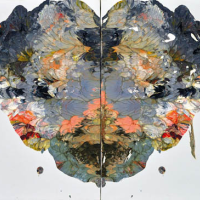BEN QUILTY

The two major motifs Ben Quilty explores most often in art are identity in post-colonial Australia and the destructive behaviours of modern masculinity ultimately both examinations of himself. The works of his 2014 exhibition at Galerie Allen in Paris are no exception. The exhibition, titled Alien, was the culmination of a three-month residency in Paris and included a poignant combination of Rorschach paintings and semi-distorted portraits, some with winding proboscis-like extension of the nose, as a kind of psychological unpacking and reordering of himself and his subjects.
The enduring tradition of portraiture no longer has the same function it once did when artists would depict their sitters somewhere between accurately and favourably, for the purposes of documentation or decoration. Contemporary portraiture inevitably delves deeper than the subjects appearance, portraying something of their psyche as well, often revealing some of the artists own self in the process. Quilty uses portraiture as a method of psychoanalysis, of both his sitters and himself. This technique was exquisitely honed through his portraits of soldiers returned from Afghanistan, where Quilty was stationed as an official war artist for the Australian War Memorial commission in 2011. This evaluation of post-traumatic stress syndrome resulted in some of the most haunting portraits in his oeuvre. The works in his 2014 Alien exhibition were an extension of this examination of collective and personal trauma. As surmised by Galerie Allen founder, Joseph Allen Shea, It is I, you, and indeed the artist himself.1
Quilty employed the present Rorschach technique to further this conversation of psychoanalysis. Colloquially known as an inkblot test, the Rorschach test was designed by Swiss psychiatrist Hermann Rorschach to determine personality characteristics and the emotional functioning of its subjects by examining their perceptions of symmetrical inkblots. Quiltys abstract Rorschach paintings invite the viewer to engage with their own sub-conscious, with each viewer inevitably asking themselves what they see and more importantly, what it might mean. During the Galerie Allen exhibition Untitled No.1 (Paris) was hung in a row of five portraits, representing the internal mind as opposed to the external face.
The Rorschach painting technique, whereby paint is applied to one canvas then pressed bilaterally against the other to create a symmetrical abstraction, is inherently imbued with chance. The pre-painted image is destroyed in the process and a new one is created not by the artists steady hand, but by the paint itself, like a disturbed monoprint that keeps both print and plate.2 This conceptual, hallucinatory painting represents the deconstruction and reassembly of not only the original image but also of ones own psyche.
Footnotes:
1. Shea, J., Ben Quilty: Alien, Galerie Allen, Paris, 2004 [accessed online]: https://benquilty.com/wp-content/uploads/2021/08/Alien_2014.pdf
2. Ibid.
Asta Cameron